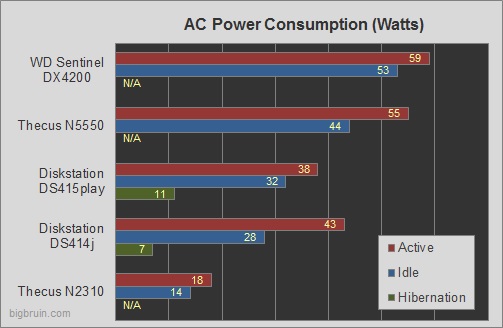Testing:
The focus of testing will be primarily to analyze read/write speeds with different types of file transfers, btu we will also take a look at AC power consumption. The WD Sentinel DX4200 was connected to a network where all wired devices feature Gigabit network adapters, and all cabling is done with CAT6 grade cables. The DX4200 was connected with a six foot CAT6 cable to a D-Link branded Gigabit switch. The computer used to access the DX4200 in this review was also connected directly to this switch with a ten foot CAT6 cable.



Testing will compare the performance of the WD Sentinel DX4200 with the following other network attached storage servers:
» Thecus N5550 4-bay NAS Server with 5x2TB drives in RAID 5
» Synology Diskstation DS415play 4-bay NAS server with 4x 2TB drives in RAID 5
» Synology Diskstation DS414j 4-bay NAS server with 4x 2TB drives in RAID 5
» Thecus N2310 2-bay NAS server with 2x 2TB drives in RAID 1
» Windows based server with 4x 3TB drives in RAID 5
The Windows server features an Intel i3-3245 processor (3.4GHz dual core), 8GB of 1600MHz DDR3 memory, and 4x 3TB Seagate Barracuda hard drives connected to a Highpoint RocketRAID PCI Express controller in RAID 5. The server uses an integrated Gigabit network adapter and is connected to the same D-Link branded Gigabit switch using a 6-foot CAT6 cable.
The desktop system used to access the various storage servers features a 240GB SATA III SSD for the operating system and a 3x 640GB drive RAID 5 array for read/writing transferred files. All devices were assigned static IP addresses by the network's router.
When it comes to transfer rate testing, the WD Sentinel DX4200 was tested three times to see how the different storage layouts would impact performance. It was tested with a simple, mirror, and parity configuration where all available storage space was assigned to the virtual disk created.
Power Consumption:
The four NAS servers and the WD Sentinel DX4200 were all plugged in to a Seasonic Power Angel monitoring device at different times in order to get real time information on the electrical current drawn while in use. The devices were tested in three conditions, where possible... 1) While the device was active - reading and writing data from two different clients in order to keep the drives spinning, 2) with the device idle - where it is fully powered up but with no active data transfers, and 3) in hibernation mode - where the disks have spun down due to inactivity to conserve electricity. The Thecus devices and the WD Sentinel DX4200 do not seem to support hibernation, so the "N/A" shown indicates it could not complete that part of the test.

I was definitely expecting the DX4200 to be the most power hungry given its hardware specifications and number of drives, so that it put up the highest figures was not a surprise. I was actually surprised that the total was less than expected. There is minimal difference between idle and load (53W versus 59W), and I could not find a way to get it in to a low power standby mode. Perhaps that is not what this device is intended for.